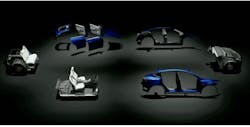China will soon shake up the U.S. electric-vehicle market with affordable vehicles, access to critical minerals and innovative approaches to production and styling. That was the overarching message at the Chicago Federal Reserve Automotive Insights Symposium in Detroit in late January.
While the 2023 event centered on what the U.S. EV transformation might look like over time, this year, China was a recurring character in almost every panel discussion, from critical minerals to the long-term outlook for EVs.
Here are five takeaways about China from the conference:
1. Chinese EV makers are coming for the U.S. market.
“How do you cut the price of EVs in half?” posited Kristin Dziczek, automotive policy advisor for the Federal Reserve Bank of Chicago. “China’s already done it.”
Dziczek recalled a Chinese auto show in 2018, awash in fever-dream contraptions that would never make it to mass production. Less than a decade later, she said, Chinese automakers are serious about making electric cars that will sell all over the world—and they are manufacturing them.
“These are not the cars with the fish tanks in the armrests and the shag carpet on the dashboard,” she said.
Dziczek shared a slick photograph of the Seagull (pictured above), an EV by Chinese automaker BYD that retails overseas for $11,500.
“This is the car that scares me,” she said. Even with tariffs, BYD can sell the car in the US for less than $15,000. “Real cars, real quality and really low prices.”
Dziczek noted that as China’s population shrinks, its manufacturing focus goes to exports. “Affordability is still a challenge” for U.S.-made EVs. “We don’t have a lot of lightly used cars. People need a car to get to work in this country. These [Chinese EVs] are going to look very attractive.”
Affordability is a big issue, said Michelle Krebs, executive analyst for Cox Automotive. With prices rising faster than wages, “10 percent of people who normally buy new vehicles have dropped out of that market” because they can no longer afford them, she noted.
2. Trading with China is not optional—the U.S. has to do it for EVs.
“Keeping China out would fracture the U.S. from the rest of the world,” said Mary Lovely, senior fellow at the Peterson Institute for International Economics. “Access to the Chinese market still remains important for American companies.”
Even when the U.S. restricts trade with China, China provides components for suppliers in countries that are U.S. free-trading partners. China also has a foothold in Mexico and Asian countries that the U.S. trades freely with, building ports and providing manufacturing and logistics services at those ports.
“All of our friends in the Indo-Pacific, except Fiji and Japan, are actually deepening their relationship with China,” said Leila Aridi Afas, Toyota North America’s director of global public policy.
Lovely added that requirements for EV credits in the Inflation Reduction Act give automakers too little time for to move away from China in terms of critical minerals. Even critical minerals mined in the U.S. are sent to China for processing. “So far the U.S. government doesn’t have a clear strategy,” she said.
The U.S. needs to prioritize expanding its critical-mineral processing capacity, said Luisa Moreno, president and director of Defense Metal Corp, a rare earths mining project in the Canadian province of British Columbia. By 2030, as EV demand grows, there will be “a tenfold increase in demand for critical minerals,” she said. “The U.S. produces about 16% of rare-earth minerals They have not been able to process them. So they export 40,000 tons to China to refine.”
Moreno noted that even the machines used to make chips for EVs require rare-earth minerals to function. “Put export restrictions on that, and you can’t make the machines.”
3. The U.S. must view China and other trading partners differently.
U.S. definitions of “friendly” and “unfriendly” trading partners are too rigid, said three members of the critical minerals panel.
“Countries that have these resources are not necessarily our friends,” said Aridi Afas. “And like-minded countries, these countries are one election away from not being our friends. … Can we look at it more strategically, that we have something to offer each other?”
Instead of a system of tariffs and bans, said Aridi Afas, trade policies should focus more on carrot than stick—giving emerging economies like Indonesia environmental and human rights standards to meet in order to trade with the U.S. With that approach, “now we’re opening up to these countries,” she said.
Line are blurred between “friendly” and “unfriendly” countries to the point that the labels aren’t useful in trade policy, said Christine McDaniel, senior research fellow at George Mason University. “We’ve been doing business with Saudi Arabia—do they share our values? … Different countries have different cost structures. That doesn’t make them not our friends. Even Mexico, they’re sending their cartels across the border. Is that our friend?”
Bringing countries up to U.S. standards is a better negotiating chip than tariffs, Moreno said.
5. China can comply with USMCA and avoid tariffs.
Under the Rules of Origin of the United States-Mexico Canada Agreement, 75% of a vehicle's content must be sourced in North America, or that vehicle will be subject to foreign-made tariffs. As long as they are compliant with USMCA rules, Chinese automakers can bypass tariffs. Some Chinese EV makers already have a U.S. manufacturing footprint in one form or another. BYD has a U.S. factory making battery-electric buses. And Geely, manufacturing EVs under the Zeekr brand, owns Volvo, which has a manufacturing plant in South Carolina.
But can a $15,000 EV made in China actually gain traction in the U.S.? "I don't know that what flies in China is going to fly in the U.S.," said Colin Langan, automotive and mobility analyst, Wells Fargo. "So maybe the slow path isn't necessarily wrong. I think there's potential [with gigacasting]. I think the traditional guys should be looking at it, but I don't think it's a slam dunk."






